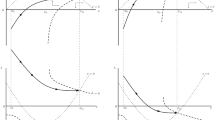Summary
A commercial horticultural industry that establishes plant-breeding nurseries for an exotic species throughout a regional economy will expand until the marginal profit of the last nursery established is zero. However, a regional government concerned with social welfare will take into account not only the profits of the horticultural industry but also any expected costs of an accidental invasion. The latter costs will consist of the discounted expected social damages due to an increase in the rate of invasion over time and the increase in expected damage cost per hectare caused by an additional nursery. A government can employ an “introducers' pay” tax equal to the latter social costs to ensure that the plant breeding industry establishes the optimal number of nurseries. We illustrate this outcome with the example of purple loosestrife (Lythrum salicaria) in North America. In the absence of any tax, the horticultural industry will establish n = 3528 nursery operations, and the expected damages from invasion are US$ 28.2 million per year. With the tax, only n = 300 nurseries are established but the expected damages from invasion are reduced to US$ 1.3 million per year. Although profits for the horticultural industry are lower from the tax, the net gains in overall social welfare more than offset the losses. Although these results are illustrative only, they show that the problem of plant invasives initiated by commercial operations is amenable to standard economic analysis and solutions, such as implementation of an “introducers' pay tax”.
Similar content being viewed by others
References
Anderson, N.O., 2004. Invasive Horticultural Crops (Part 3): Who's monitoring & controlling them? Minnesota Nursery and Landscape Association, MNLA News 28(6): 45–47.
Anderson, N.O. & P.D. Ascher, 1993. Male and female fertility of loosestrife (Lythrum) cultivars. J Am Soc Hort Sci 118(6): 851–858.
ATTRA, 1996. Purple loosestrife: Public enemy on federal lands. ATTRA Interior Helper 1(2): 2.
Barbier, E.B., 2001. A note on the economics of biological invasions. Ecol Econ 39(2): 197–202.
Brooks, D., 1997. Introduction of non-native species: Ecology and economics. In: O.T. Sandlund & A. Viken (Eds.), Report of the Workshop on Freshwater Biodiversity. Directorate for Nature Management/Norwegian Institute for Nature Research, Selbu, Norway, June 5–7.
Cropper, M., 1976. Regulating activities with catastrophic environmental effects. J Environ Econ Manage 3: 1–15.
Dalsimer, A.A., 2000. Predicting the spread of non-indigenous invasive plant species: Can it be done? Georgetown Public Policy Institute (Thesis). Available athttp://www.denix.osd.mil /denix/public/news/osd/niwaw/invasive-thesis/weedstock.html.
Hager, H.A. & K.D. McCoy, 1998. The implications of accepting untested hypotheses: A review of the effects of purple loosestrife (Lythrum salicaria) in North America. Biodiv Conserv 7: 1069–1079.
Keeler, E., M. Spence & R. Zeckhauser, 1972. The optimal control of pollution. J Econ Theory 4: 19–34.
Knowler, D. & E. Barbier, 2000. The economics of an invading species: A theoretical model and case study application. In: C. Perrings, M. Williamson & S. Dalmazzone (Eds.), The Economics of Biological Invasions. Cheltenham, UK.
Kolar, C.S. & D.M. Lodge, 2002. Ecological predictions and risk assessment for alien fishes in North America. Science 298(8): 1233–1236.
Naylor, R.L., 2000. The economics of alien species invasions. In: H. Mooney & R. Hobbs (Eds.), Invasive Species in a Changing World, pp. 241–259. Island Press, Washington, DC.
OTA, 1993. Harmful non-indigenous species in the United States. U.S. Congress, Office of Technology Assessment, OTA-F-565. U.S. Government Printing Office: Washington, DC. Available athttp://www.wwe.princeton.edu/cgi-bin/byteserv.pr1/ ∼ota/disk1/1993/9325/9325.pdf.
Perrings, C., M. Williamson, E. Barbier, D. Delfino, S. Dalmazzone, J. Shogren, P. Simmons, & A.Watkinson, 2002. Biological invasion risks and the public good: An economic perspective. Conserv Ecol 6(1): 1. Available athttp://www.consecol.org/vol6 /iss1/art1.
Pimental, D., L. Lach, R. Zuniga, & D. Morrison, 2000. Environmental and economic costs of nonindigenous species in the United States. Bioscience 50(1): 53–67.
Pursh, F., 1814. Flora Americae Septentrionalis; or, A systematic arrangement and description of the plants of North America. White, Cochran & Co., London.
Reed, W.J. & H.E. Heras, 1992. The conservation and exploitation of vulnerable resources. Bull Math Biol 54(2/3): 185–207.
Reichard, S.H. & C.W. Hamilton, 1997. Predicting invasions of woody plants introduced into North America. Conserv Biol 11(1): 193–203.
Sain, G.E. & H.J. Barreto, 1996. The adoption of soil conservation technology in El Salvador: Linking productivity and conservation. J Soil Water Conserv 51(4): 313–321.
Shigesada, N. & K. Kawasaki, 1997. Biological Invasions: Theory and Practice. Oxford University Press, Oxford.
Smith, C.S., W.M. Lonsdale & J. Fortune, 1999. When to ignore advice: Invasion predictions and decision theory. Biol Invasions 1: 89–96.
Thompson, D.Q., R.L. Stuckey & E.B. Thompson, 1987. Spread, impact, and control of purple loosestrife (Lythrum salicaria) in North America Wetlands. Fish and Wildlife Research 2. US Dept of the Interior, Fish and Wildlife Service, Washington, DC.
Tsur, Y. & A. Zemel, 1994. Endangered species and natural resource exploitation: Extinction vs. coexistence. Nat Resour Model 8(4): 389–413.
USDA, 2001. 1998 Census of Horticultural Specialties. U.S. Department of Agriculture, Washington, DC. Available athttp://www. nass.usda.gov/census/census97/horticulture/horticulture.html.
Varian, H., 1984. Microeconomic Analysis, 2nd ed. W.W. Norton, New York.
Williamson, M., 1996. Biological Invasions. Chapman & Hall, London.
Author information
Authors and Affiliations
Corresponding author
Rights and permissions
About this article
Cite this article
Barbier, E., Knowler, D. Commercialization decisions and the economics of introduction. Euphytica 148, 151–164 (2006). https://doi.org/10.1007/s10681-006-5949-1
Issue Date:
DOI: https://doi.org/10.1007/s10681-006-5949-1




